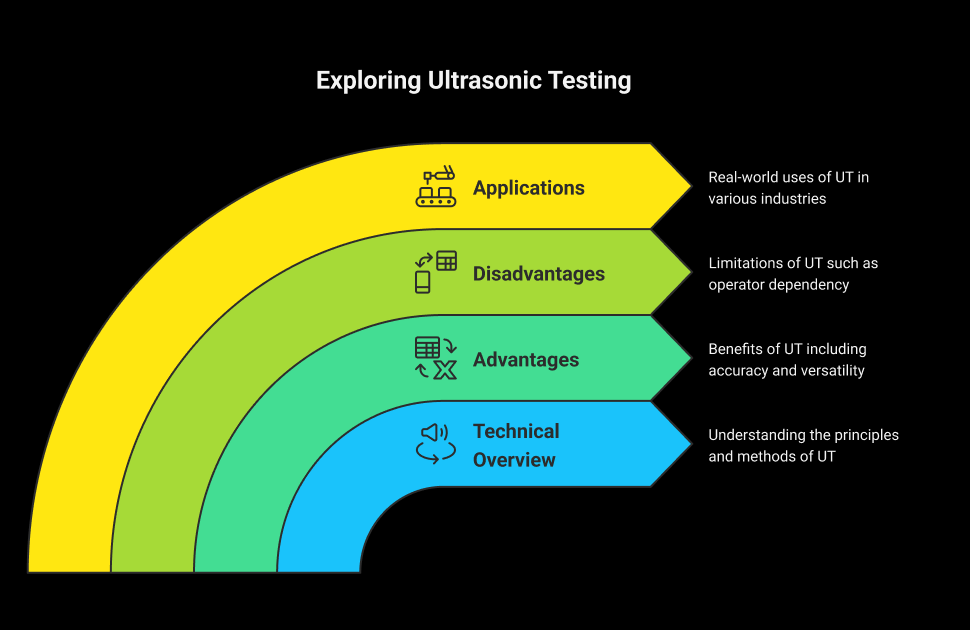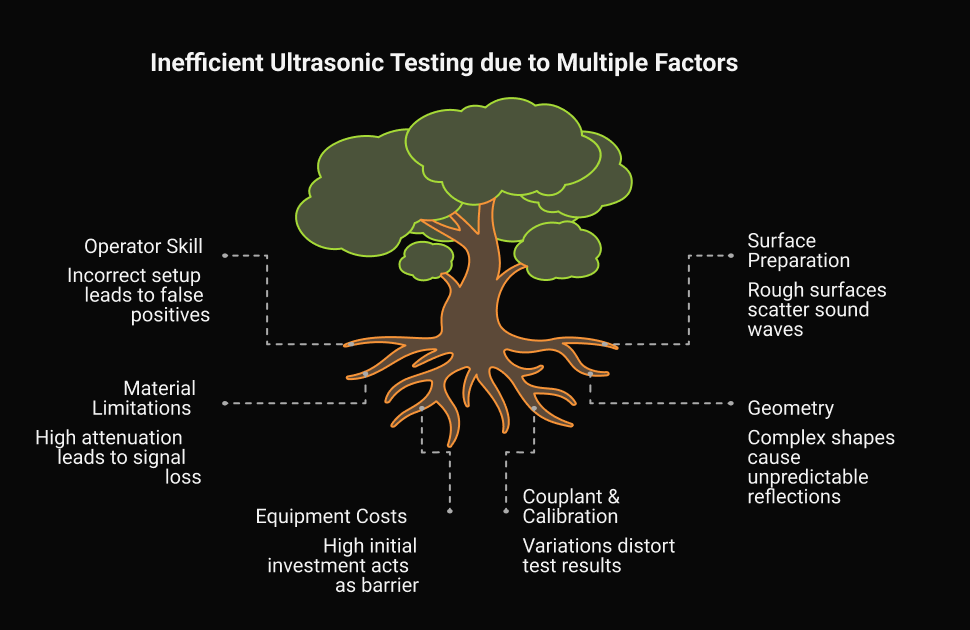Table Of Contents
- Introduction
- How Ultrasonic Testing Works
- Advantages of Ultrasonic Testing
- Disadvantages of Ultrasonic Testing
- Practical Applications and ROI Examples
- Conclusion
Introduction
Ultrasonic Testing (UT) is one of the most common non-destructive testing (NDT) methods, which involves the use of high-frequency sound waves (usually between 0.5 and 20 MHz) to identify discontinuities in the interior of a material or to determine the thickness of the material. When it is fed into a material with ultrasonic waves through a transducer, some of the sound will be reflected back into it provided it contains some fault, whether it is a crack, void, or an inclusion. Through reading these reflected signals, the inspection officers can know the position, size and nature of the defects with a very high degree of accuracy. UT has wide use in many industries like oil and gas, power generation, aerospace and manufacturing industries where structural integrity of parts of the components, such as welds, castings, and forgings, is important.
Technically, ultrasonic testing has some advantages such as deep penetration, high sensitivity, real assessment, and safe testing, which does not involve exposure to radiation. Nevertheless, it also has some limitations like reliance on the skill of operators, surface preparation and constraints in operation on coarse-grained or irregular materials. Knowledge of these technical advantages and disadvantages is critical in the selection of the right method to use in inspection by the engineer, inspector as well as NDT professionals when choosing the right method to use in a particular application.
By being exposed to this article, you will have a clear picture of how ultrasonic testing operates, the key advantages of the test, and the fundamental constraints of the test. You will also find out how UT would compare with other NDT techniques in regard to accuracy, applicability, and cost-effectiveness, to assist you in making a good decision when planning a reliable inspection and quality assurance.

How Ultrasonic Testing Works
The ultrasonic testing uses high-frequency sound waves that commonly exhibit a frequency of between 0.5 to 20 MHz in detecting internal faults in materials. Ultrasonic pulses pass through the material due to the transducer. These waves would reflect on the transducer when they hit a flaw, e.g. a crack or a hole. The time-of-flight and amplitude of these reflections are examined to deduce a size of the defect, its location and the nature. Such typical UT methods are pulse-echo, through-transmission, phased array ultrasonic testing (PAUT). What is the process? It consists of calibration of the equipment, the use of a couplant (e.g. gel or water to aid the transmission of the sound) and then scanning the test surface. The accuracy of measurements and real-time data are what makes UT a preferred approach to NDT professionals.
Advantages of Ultrasonic Testing
1. High Accuracy and Sensitivity
UT is very sensitive and can determine very small internal defects such as cracks, inclusions or voids. Depending on the frequency and material properties, it is able to resolve flaws as small as 0.5mm. UT is used when inspecting welds to obtain a determination of the size, depth, and orientation of the weld defect which is used when making any decision to repair them. High-complex procedures such as PAUT are able to utilize many transducers at many angles, which enhance the evaluation of defects in complicated geometries, like pipeline girth welds.
2. Deep Penetration
UT is capable of penetration in heavy material, such as several meters into a metal such as steel. This qualifies it to be used in situations where heavy parts like pressure vessels or big forgings are to be checked and the other techniques like radiography could not be very effective. UT balances the need to optimize penetration and resolution by balancing the frequency, thus enabling sound results when used over various thicknesses of materials.
3. Non-Hazardous Operation
UT unlike radiographic testing, which involves using ionizing radiation, UT leverages on sound waves, which do not pose any dangerous health risk to the operator and any nearby staff. This removes the problem of exclusion zones, shielding and special permits, which makes UT safer and more feasible in use in live facilities. Compliance cost and operational interruption because of lack of radiation.
4. Real-Time Results
UT feedback is immediate, and the digital systems indicate the defect data when scanning. This enables the inspectors to make quick decisions and the inspection process is shortened. As an example, during the pipeline weld testing, the results of the UT made in real time make it possible to quickly detect and correct defects, thereby reducing the amount of unproductive time in emergency operations.
5. Versatility Across Materials and Applications
UT works with a broad variety of materials such as metals, composites, ceramics, so long as they conduct sound. It is applied in aerospace as parts of composite laminates, oil and gas as parts of pipeline weld, and the power generation industry as parts of turbine blades. The flexibility of its adaptation to a variety of applications can be increased with such techniques as immersion UT or contact UT that can be customized according to the components.
6. Analysis Digital Data
A new generation of UT devices produces digitally rendered outputs that are easy to store, analyze, and share. This helps in predictive maintenance as far as defect progress is monitored with time. As an example, measurement of UT thickness in pipelines will be able to track the rate of corrosion to conduct proactive maintenance. With electronic documentation, compliance with the regulatory process and audit becomes easy.
7. Portability
UT equipment, especially handheld equipment, is field-friendly and small in size. Portable systems can be used to carry out inspections where the site is remote, e.g. on offshore platforms or offshore construction sites. The battery-powered systems offer mobility where UT can be used to work in harsh conditions without reduced accuracy.

Disadvantages of Ultrasonic Testing
1. Operator Skill Dependency
UT mainly relies on the skill of the operator. Intensive training and certification (e.g., ASNT Level II or III) is needed to properly calibrate, select probes, interpret signals and so on. Problems of incorrect setup or signal misinterpretation may cause false positives or other defects not detected. As an example, a complicated weld can have several strikebacks, and a talented interpreter can tell the difference between what is flaw and the noise in the background.
2. Surface Preparation Requirement
UT needs a clean and smooth surface to facilitate proper propagation of sound waves. Waves can be scattered by rust, scale, or rough surfaces and cause lack of precision. An air gap should be removed by using a couplant, an addition to the preparation procedure. Cleaning of large pieces of equipment, such as pipelines, is time-consuming and labor-intensive within the field which increases cost of inspection.
3. Lack of Performance on some Substances
UT would not work well with materials that have a high sound attenuation feature, which includes fine grains of casting or porous composite. The waves are either dispersed or absorbed in these materials which leads to loss of clarity of signal. As an example, the austenitic stainless steel is notorious to test its welds because of grain interferences, which in most cases may require dedicated probes or methodology.
4. Geometry Limitations
The UT inspection can be complicated by the complex shape that may be in the form of a curved surface or an irregular weld. Sound waves can bounce off in an unpredictable way and provide spurious indications or conceal defects. The PAUT counteracts it by enhancing multi-angle beams, but needs complex equipment and skill, which adds costs. UT cannot correctly be done with standard UT on complex parts such as the turbine blades.
4. Equipment Costs
UT is economical to use long term in comparison with radiography, but the purchase cost of new equipment is also considerable, and it is more so in the case of the more modern systems such as PAUT. The cost is contributed by high-frequency transducers, digital flaw detectors and software licenses. As far as smaller operations are concerned, such an upfront expense acts as a barrier, but cumulatively, such savings tend to justify the investment.
5. Couplant and Calibration sensitivity
UT is accurate when there is a regular application of the couplant and accurate calibration. The ends can distort the results due to difference in thickness of couplant or some lack of calibration. To illustrate, poor couplant of contact UT can make signals weak which may miss defects. The checks of the calibration are needed on a regular basis and complicate the process.
7. Impaired Visual Output
Contrary to RT, UT is based on signal interpretation, not on clear radiographic visualizations as in the case of RT. This is not as intuitive visual as RT, and also more difficult to share the information with non-experts. Although PAUT may produce 2-dimensional or 3-dimensional images, they are more complicated and may need special software as well as training.

Practical Applications and ROI Examples
The properties of UT make it one of the favorite UT applications. According to the oil and gas industry, a pipeline operator was able to perform UT inspection of girth welds to crack early and save an expected cost of repair of $200,000 in the event of a failure. Real-time information and transportability of UT minimized inspection by 30 percent which amounted to saving $50,000 in downtimes. Targeting aerospace, UT has failed to detect delaminations in composite aircraft materials, avoiding unscheduled in-service failures with all the associated costs. Nevertheless, when applied to coarse-grained castings the weaknesses of UT could be observed in terms of a single case, when signal noise resulted in nonsignificant outputs, which would ultimately need additional testing. The use of UT in combination with other techniques made thorough inspection in cases like this possible.
1. Optimal Ultrasonic Testing
In order to reap the maximum of the benefits of UT, NDT technologists must make an investment in the training to provide the accurate interpretation of signals and must apply more complicated methods such as PAUT to complex shapes. Effective surface treatment and calibration are important to valid results. Assessment of difficult materials or shapes With troublesome materials or shapes, limitations can be overcome by using UT in a composite or allied technique, such as RT. The accuracy of UT systems can be further increased by the digitalization through AI-assisted analysis to eliminate operator error and discover defect trends to conduct predictive maintenance.
2. Getting the Right Method
UT strengths and weaknesses will be important to know to any NDT professionals, students, and researchers in order to make a good inspection plan. Its extremely high accuracy, deep penetration, safety and versatility lends to the fact that it is suitable to the majority of weld and material inspections. But it depends on the skill of the operator, the preparation of surface, and whether it cannot be used with all materials or geometries, which must be considered. UT can produce dependable results by treating these issues with training, equipment, and procedures. Not so sure that UT is the right solution to your project? Inspection audits, which are conducted in a high degree of detail, can allow choosing the best NDT method, which will be safe, efficient and cost-effective.
Conclusion
Ultrasonic Testing is a highly proficient NDT technique that provides good accuracy, healthiness, and real-time monitoring in monitoring welds and materials. It can also penetrate high materials to give digital information that is useful in the oil and gas industry, aerospace and manufacturing industries. Nevertheless, it relies on experienced operators, requires surface preparation, and has constraints of its use with particular materials or shapes. It is possible to make the most out of it, by following the appropriate procedures and using UT techniques, which are advanced. Make your checks as efficient as possible- select UT, economies of time and expenditure, and failures also.
20251106001151.png)








